
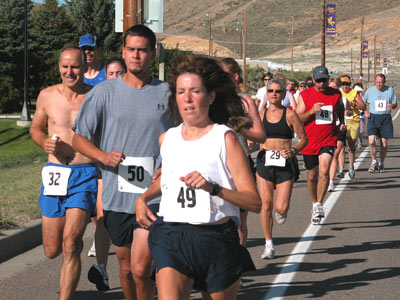 •Green River.
We took the fast lanes across southern Wyoming.
The wet spring and summer had turned the rolling countryside—usually dry-grass
brown—into a green blanketed grassland unusual for mid-July. We stopped in
Green River early enough to bike through this small railroad town on their
system of bike paths that run through town and skirt the Green River. As
we were heading back to the motel, we noticed an sign announcing a 5K race
the following morning. After several phone calls, we learned the location
and time of the race in the morning. Registration was $10 which included
a T-shirt, age group prizes, a raffle of gift certificates, and a timer.
At 8:00 a.m. the sun was already strong and hot, and the route was deceptively
challenging: gentle but long uphills and a couple of striking downhills along
the way. Number 29 was the 4th woman and won the women's 50+ age group.
•Green River.
We took the fast lanes across southern Wyoming.
The wet spring and summer had turned the rolling countryside—usually dry-grass
brown—into a green blanketed grassland unusual for mid-July. We stopped in
Green River early enough to bike through this small railroad town on their
system of bike paths that run through town and skirt the Green River. As
we were heading back to the motel, we noticed an sign announcing a 5K race
the following morning. After several phone calls, we learned the location
and time of the race in the morning. Registration was $10 which included
a T-shirt, age group prizes, a raffle of gift certificates, and a timer.
At 8:00 a.m. the sun was already strong and hot, and the route was deceptively
challenging: gentle but long uphills and a couple of striking downhills along
the way. Number 29 was the 4th woman and won the women's 50+ age group. 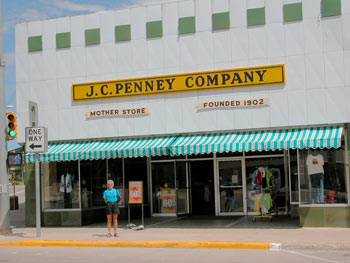 fossil fish and palms are on display in town and at the the Fossil Butte
National Monument just west of town. Kemmerer is also home to the annual
Oyster Ridge Music Festival,
the state's largest free music festival. This three-day event each July
features bluegrass and Celtic bands with performers from the USA and Canada.
fossil fish and palms are on display in town and at the the Fossil Butte
National Monument just west of town. Kemmerer is also home to the annual
Oyster Ridge Music Festival,
the state's largest free music festival. This three-day event each July
features bluegrass and Celtic bands with performers from the USA and Canada.
 recorded, including the individual—visitor or on-site expert—who discovered
the fossil.
recorded, including the individual—visitor or on-site expert—who discovered
the fossil. 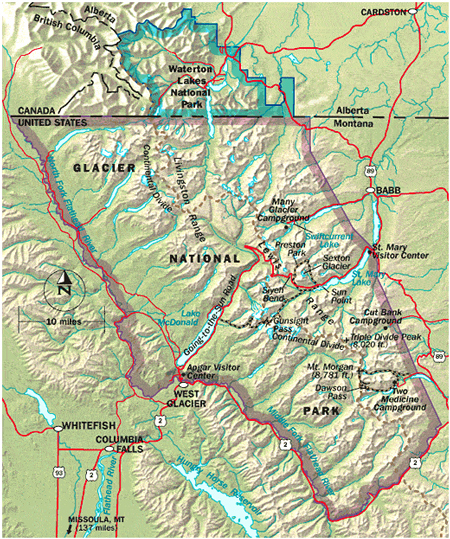
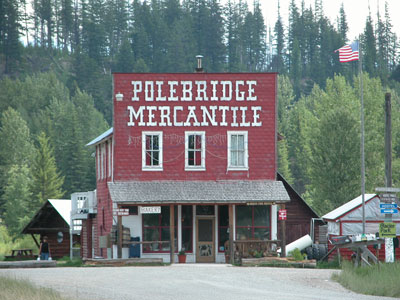 And a good thing we did: less than an hour later, on the drive back, the
heavens opened up and demonstrated why this part of the country is so green
in the summer.
And a good thing we did: less than an hour later, on the drive back, the
heavens opened up and demonstrated why this part of the country is so green
in the summer. do not often help to locate trailheads or to decide which fork to take. We
spent our first day in the west side of the Park—West Glacier Village, Lake
McDonald, and eventually to the "halfway" point in the park: Logan Pass (6,646').
Along the Going to the Sun Road, we stopped to see waterfalls, to walk along
the Flathead River, to photograph the not so shy mountain goats and majestic
bighorn sheep that pose for visitors on a trail near Logan Pass. We also
stopped for conversations with road workers who held up traffic at half a
dozen locations along this much used narrow mountain road through the Park.
We did not get into the back country where grizzlies, elk, moose, and other
large mammals dominate (in fact, we never saw an elk or moose, and the only
bear we saw was on a highway outside the park), but we'll save that for another
trip. We only hope that the weather then will be as fine and fair as it was
this time.
do not often help to locate trailheads or to decide which fork to take. We
spent our first day in the west side of the Park—West Glacier Village, Lake
McDonald, and eventually to the "halfway" point in the park: Logan Pass (6,646').
Along the Going to the Sun Road, we stopped to see waterfalls, to walk along
the Flathead River, to photograph the not so shy mountain goats and majestic
bighorn sheep that pose for visitors on a trail near Logan Pass. We also
stopped for conversations with road workers who held up traffic at half a
dozen locations along this much used narrow mountain road through the Park.
We did not get into the back country where grizzlies, elk, moose, and other
large mammals dominate (in fact, we never saw an elk or moose, and the only
bear we saw was on a highway outside the park), but we'll save that for another
trip. We only hope that the weather then will be as fine and fair as it was
this time.
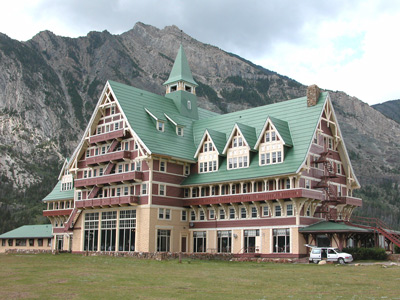
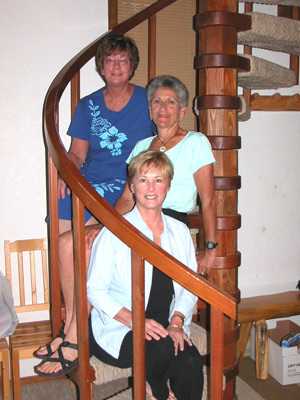 the patio to watch the sun go down over the Livingston Range to the west.
Reservations are almost certainly required! We marveled at the magnificent
three story lobby supported by massive beams carved from trees hundreds of
years old.
the patio to watch the sun go down over the Livingston Range to the west.
Reservations are almost certainly required! We marveled at the magnificent
three story lobby supported by massive beams carved from trees hundreds of
years old. 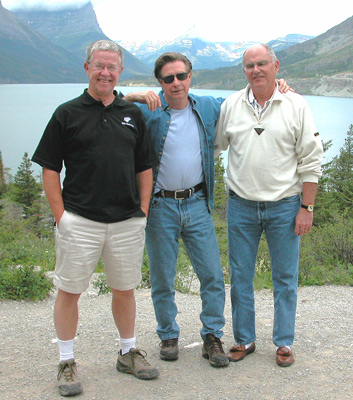 through or on the fringe of some of Montana's most scenic areas, with names
that conjure images of the mining frenzy that brought European Americans
to this wild land with the promise of fortunes to be dug from the earth:
the Garnet Range, Stone, and Opportunity; ghost towns of Phillipsburg, Garnet,
and Virginia City. Butte, once the
richest copper mining area in the country has lost its economic base (the
1700' deep Berkley Pit is a stark reminder of those former mining days),
but the city seems to be making a comeback through promoting its history
and the area's natural beauty. Hot springs can be found around almost every
bend in the road—Sleeping Child Hot Springs, Bozeman Hot Springs, Chico Hot
Springs— leading to the mother of all hot springs at Yellowstone to the south.
US Highway 212 that runs southwest from Billings through Red Lodge past Granite
Peak (high point in the state at 12,799') to Yellowstone is considered by
many to be the most beautiful road in the country. All this waits for another
trip.
through or on the fringe of some of Montana's most scenic areas, with names
that conjure images of the mining frenzy that brought European Americans
to this wild land with the promise of fortunes to be dug from the earth:
the Garnet Range, Stone, and Opportunity; ghost towns of Phillipsburg, Garnet,
and Virginia City. Butte, once the
richest copper mining area in the country has lost its economic base (the
1700' deep Berkley Pit is a stark reminder of those former mining days),
but the city seems to be making a comeback through promoting its history
and the area's natural beauty. Hot springs can be found around almost every
bend in the road—Sleeping Child Hot Springs, Bozeman Hot Springs, Chico Hot
Springs— leading to the mother of all hot springs at Yellowstone to the south.
US Highway 212 that runs southwest from Billings through Red Lodge past Granite
Peak (high point in the state at 12,799') to Yellowstone is considered by
many to be the most beautiful road in the country. All this waits for another
trip. |
|
|